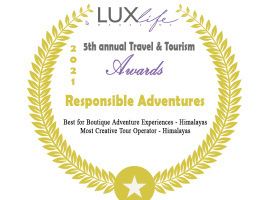Bhutan, the People, Culture and Religion
Bhutan had remained cut off from the outside world due to its remarkable geographical location. Part of this isolation was self-formed to protect its civilizations, unique identity, and independence from the rest of the world. The nation was observing strict segregation that tourism allowed foreigners to enter Bhutan from 1974.
The Bhutanese mostly speak Dzongkha, Sharcop, the leading local languages, and Nepalese. The first two languages are linked to the Tibetan language, and the monks use the Tibetan scripture and language called Chokkey.
The Bhutanese are similar to Tibetans and share distinct similarities in their arts, crafts, jewellery, and handicrafts. The Bhutanese and Tibetans both worship and revere Guru Padmasambhava or Guru Rimpoche. He was the tantric sage who introduced Buddhism into Tibet, which later followed into Bhutan.
However, Bhutan’s people, culture, religious practices, and traditions have several distinct features.
People of Bhutan
According to a recent report in March 2017, Bhutan’s population is 789936 based on the United Nations estimate. They make up a mere 0.01% of the world population. Bhutan ranks 164 on the population list in the world. An estimated 40% of the population lives in the urban area, and the average age is pretty low at 27 years.
Bhutan is sparsely populated in the mountainous and severely cold regions of the higher Himalayas and the arid tracts on the southern border with India’s Duars plains. The most populated areas of Bhutan are the fertile regions with the temperate climate of Central, Western, and South West (near the Indian border)
The most populated Dzongkhags (administrative districts) are Thimpu, Chuka, Sarpang, Paro, and Phuentsoling, while Gasa remains one of the least populated Dzongkhags.
Except for a few fixed roles based on gender, equality between females and males exists in traditional Bhutanese society. An excellent example of a selected function would be a man who works as a cloth maker while the woman is a weaver. Interestingly, both men and women work in villages, while in cities and towns, the man is the breadwinner while the woman is a homemaker.
Arranged marriages do take place, but young couples choose their partners. Unions can be registered officially and sometimes involuntarily when the team has lived together for more than six months. Divorce isn’t uncommon at all; neither is it considered taboo.
Both the government and the people of Bhutan give priority to education. It is accessible in Government schools until the higher secondary level, where students receive partial or complete scholarships depending on their merits. Once again, there is no disparity between the genders in education.
The Bhutanese are a matriarchal society; the groom moves into the bride’s home after marriage. However, these days, most couples prefer to live separately on their own. Bhutan is a rare South Asian country that doesn’t practise the dowry system; the youngest daughter inherits her parental property (matrilineal). Women are not obligated to take on their father or husband’s name.
Women also have no obligation to take on their father or husband’s name. As a result, polygamy and Polyandry are not uncommon.
You will find many people with the same combination due to a limited selection of names in Bhutan. Sometimes they even use the name of their locality, village, or even their house for identification.
There are fixed prayers and meal routines, and people observe the timings strictly. For example, the immigration off closes for thirty minutes precisely for lunch. Workingmen and women in offices or shops settle down to have their staple meal of ema datsi or rice around 2 pm.
The honesty of the Bhutanese is what fascinates visitors to his nation. There have been cases where people got the shop owners have returned their lost belongings or extra money visitors paid.
The Bhutanese are courteous to all visitors, no matter where they come from.

Behavioural Code of Bhutan
The Driglam Namzha is a formalized national dress and behavioural code. This code explains how the citizens of Bhutan have to dress and behave in public places. Driglam means discipline, regimentation, order, and custom, while Namzha means the system. The composite term implies The rule of regulation in behaviour. All citizens of Bhutan have been supposed to follow the Driglam Namzha since 1990.
Cleanliness is taken very seriously by the Bhutanese Government, and they have initiated a series of rules and regulations to uphold the value of cleanliness and orderliness in the country. However, one can see the stark difference between the Bhutanese and Indian administrative systems in the border town of Phuentsoling and Jaigaon.
The noisy, dirty ambience of the Indian border town of Jaigaon is a sharp contrast to the clean and orderly city of Phuentsoling in Bhutan. Some signages encourage the practice of cleanliness in every central public place, including roads and areas of interest. Streets are regularly swept, and public toilets and all tourist places of interest are kept clean by the government.
Dress Code
Bhutanese men dress up in a knee-length robe that is tied at the waist with a belt. This dress is called Gho, whereas the women wear colourful blouses with a large rectangular cloth tied at Kira’s waist. In addition, the women often wear a bright brocade jacket over the blouse. All Bhutanese follow this dress code for official visits, occasions, public ceremonies, and festivals.
Religion
Buddhism is the principal religion of Bhutan, and it reflects clearly in all domains of life there. Household items and utensils have religious symbols; prayer flags fluttered on hills, roads, bridges, and trees. Religion here is a way of life that surrounds their lives.
You will observe that almost all roofs have a slight white prayer flag fluttering on top. This indicates that the owner has offered to the local deity for appeasement. Each district of Bhutan is known as a Dzongkhag, consisting of a Dzong (Fort) with massive walls that serve as a religious and administrative hub. Apart from a monastery and prayer hall, these Dzongs have chambers of justice, formal rooms, and a coronation chamber.
You will be struck by the vision of groups of monks wandering through the town and city roads, getting on with their daily activities. The monks enjoy worldly pleasures such as eating out, Facebook profiles, an expensive smartphone, and even a car, unlike the monks in South East Asia. The families still practice sending a son to serve in a monastery and are highly regarded and believed to gain good merits to both the novice monk and his family.
A typical age for a child to be sent to monastic life is between 6 and nine years of age and lives under a principal’s rule. They get to learn Chokhey, English, Dzongkha, and Buddhist philosophy. However, there comes a time when a monk has to decide on whether he wants to pursue Theology or become a practitioner of faith.

A monk who has chosen a life of spiritual learning must report to his master. There is an Abbot or a Lama in every monastery. The highest-ranking Lama of the land is called The Je Khenpo ( National Chief Abbot who is revered equally as the King)
The most significant Dzong of the country is the Punakha Dzong. It holds the preserved body of Shbdrung Namgyal, and 600 monks of the central body perform all the nation’s principal religious duties.
Bhutan was a pure monarchy until 1950 before it started to transform towards democracy slowly. The most powerful political leaders are the King (Jigme Namgyal Wangchuk) and the Prime minister (Tshering Tobgay), not forgetting Je Kempo’s religious leader. The Royal family of Bhutan is loved dearly by the entire nation. Their photos are framed and can be seen in each household.
Bhutan is known worldwide for their impression of a happy and content nation governed by its national slogan of “Gross National Happiness.”
Check out our Trekking packages for Nepal, Bhutan, India, and Tibet.
















